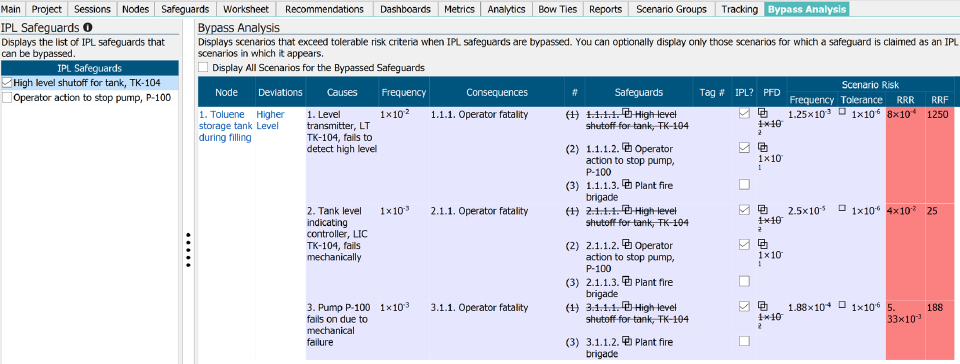PT Notes
Safeguards Bypass Analysis Using LOPA
PT Notes is a series of topical technical notes on process safety provided periodically by Primatech for your benefit. Please feel free to provide feedback.
Process safeguards sometimes must be bypassed, inactivated, or suspended, usually for a short period of time. For example, bypassing safeguards commonly occurs during process startup, maintenance, or the investigation of problems with process operation. Bypassed safeguards increase process risks and catastrophic accidents have resulted when safeguards were bypassed.
Typically, extra precautions are taken when safeguards are bypassed. For example, during startup, reliance usually is placed on operators to manually control the process by carefully monitoring process variables until the safeguards can be restored to operation. Maintenance may require equipment safeguards, such as relief valves, to be removed from service. In such cases, reliance may be placed on redundant over-pressure protection, such as dual relief valves, or the use of temporary protection measures, such as operating a process at lower pressures. However, bypassing a safeguard may still result in the realization of the hazard the safeguard is designed to protect against causing adverse impacts on people, the environment, and property. Consequently, bypassing safeguards must be managed carefully.
It is important to recognize that previously bypassing safeguards without incident does not guarantee that incidents will not happen the next time around. A history of safe bypasses can lead to complacency and a false sense of security for process personnel.
A bypass management program should be in place that addresses:
- What hazards does the safeguard protect against?
This information helps to determine the risks that must be mitigated during the safeguard bypass period. Process hazard analysis (PHA) studies can be examined to identify the hazards addressed by a safeguard. - Are new hazards introduced as a result of the bypassed safeguard or compensating measures taken to address it?
This information determines the possible need for safeguards to protect against any new hazards. New hazards can be identified by performing a management of change (MOC) PHA. - Is the increase in risk tolerable?
LOPA can be used to evaluate the increase in risk when one or more safeguards are bypassed. It can also be used to determine if the residual process risk after any compensating measures have been taken is tolerable for the duration of the bypass. LOPA can identify which hazard scenarios for a process increase in risk as well as the cumulative impact on process risk of bypassing multiple safeguards.
LOPA can also be used to determine the robustness of the existing safeguards architecture to bypassing safeguards, for example, the value of redundant safeguards. This can be a useful tool during process design.
The circumstances under which safeguards can be bypassed and the reasons should be documented in operating procedures, together with responsibilities and authorities, and communicated to affected personnel. Safety-critical safeguards that cannot be bypassed at all should be identified to ensure the safe operation of a process under all conditions.
PHA and LOPA provide vital information for planning safeguard bypasses. An example of using PHA and LOPA for safeguards bypass analysis is shown below.

If you would like further information, please click here.
To comment on this PT Note, click here.
You may be interested in:


